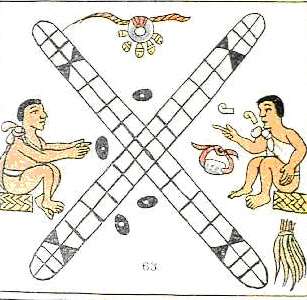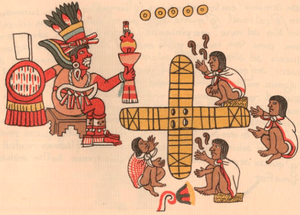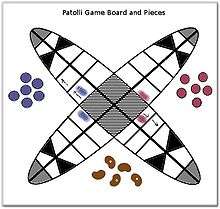Patolli


Patolli (Nahuatl: [paˈtoːlːi]) or patole (Spanish: [paˈtole]) is one of the oldest known games in America. It was a game of strategy and luck, played by commoners and nobles alike. It was reported by the conquistadors that Montezuma often enjoyed watching his nobles play the game at court.
History
Patolli or variants of it was played by a wide range of pre-Columbian Mesoamerican cultures and known all over Mesoamerica: the Teotihuacanos (the builders of Teotihuacan, ca. 200 BC - 650 AD) played it as well as the Toltecs (ca. 750 - 1000), the inhabitants of Chichen Itza (founded by refugee Toltec nobles, ca. 1100 - 1300), the Aztecs (who claimed Toltec descent, 1168 - 1521), and all of the people they conquered (practically all of Mesoamerica, including the Zapotecs and the Mixtecs). The ancient Mayans also played a version of patolli. Anthropologist E. Adamson Hoebel (1966) says the Aztec patolli derives from the East Indian game of pachisi,[4] but R.B. Lewis of the Department of Anthropology at the University of Illinois (1988) says that the two games were independently developed and that the similarity between them is merely due to the limitations of a board game,[5].
Players
Patolli is a race/war game with a heavy focus on gambling. Players would meet and inspect the items each other had available to gamble. They would bet blankets, maguey plants, precious stones, gold adornments, food or, in extreme cases, their homes and sometimes their family and freedom. Agreeing to play against someone was not done casually as the winner of the game would ultimately win all of the opponent's store of offerings.
Each player must have the same number of items to bet at the beginning of the game. The typical number of items to bet is six, because each player has six markers (each time a marker successfully completes a circuit around the board, the opponent is required to hand over one of their items); although any number would be acceptable as long as each player agreed.
Once an agreement is made to play, the players prepare themselves by invoking the god of games, Macuilxochitl.
Gameplay and game pieces
The object of patolli is to move six game pieces to the end of a board composed of specially-marked squares.[2] In order to complete a round, a player needs to get all of the six game markers from the starting queue position to the ending square position on the game board before the other player. The ultimate goal of the game is for a player to win all of the opponent's treasure; to do this, the players may need to play more than one round of the game.
Five or six black beans were used as dice.[2] Each bean had one side marked with a hole; thus, tossing the black beans would result in some showing this white mark and others showing a blank side. Dice were also used,[1] but the rules in this article pertain to the bean version.
The game pieces were six red and six blue pebbles;[2] each player controlled one color. Beans, kernels of maize, or even pieces of jade could also be used.
The game board had 52 squares arranged in an "X" shape, painted on it with liquid rubber.[2] The game board could also be drawn on a bit of leather or on a straw mat and decorated with colored dye, or carved into the floor or a tabletop.

The players take turns tossing the beans onto the game area. In order for a player to get one of their markers on the game board, one bean would have to land with its hole face up and all the others face down (getting a score of one). Once a player has done so, the game begins and the player is allowed to place one of their game markers from their starting queue onto the starting square of the game board. If a player already has a marker on the game board, they can move it forward (clockwise around the X) the same number of spaces as there are holes showing from the toss. A toss showing five holes allows the player to move their marker ten spaces forward. If the player cannot move any of their markers because they would overshoot the ending square or land on a spot occupied by either player, then they lose the turn.
If a player's marker reaches the ending square by exact count, the marker is removed from the board and the opponent must give up one of their treasures to the player. The round is over once one player gets all six of their markers off the board this way. The game is over as soon as one player acquires the last of his or her opponent's treasures; that player is the winner. If no player has won by the end of a round, then the players must play another round.
There are several specially-marked areas on the game board. The four squares in the middle of the X are one of these special areas. Landing on an opponent's marker in this area is allowed, and if a player does so, the opponent's marker is removed from the game board and put back into the opponent's starting queue. The opponent is then required to give up one of their treasures to the player. Another special area is marked by two dark triangular spaces near the end of each arm of the X. If a player lands on one of these triangular spaces, the player must give up one of their treasures to the opponent. The final special areas are the two special squares marked at the end of each arm of the X. A player who lands on one of these squares takes another turn.
If a toss results in all the beans standing on their sides, then the tosser automatically wins all the goods bet by both parties.[2]
According to the Magliabechiano codex, the god Macuilxochitl is considered to be participating in the game.[2] There is a special space above the game board reserved for offerings to Macuilxochitl. A player must place one of their treasures into this space each time their toss results in a score of zero (no holes showing). The winner of the round receives all the treasure located in this space as a gift from Macuilxochitl.
Spanish Conquest
The Spanish priests forbade the game during the Spanish conquest of Mexico, possibly due to people selling themselves and their families into slavery over it. They were even known to have burned the hands of people caught playing the game.
See also
References
- 1 2 Rees, R. (2006). Understanding people in the past: The Aztecs. Reed Elsevier Inc.: Chicago ISBN 1-403-48749-9 pp. 35
- 1 2 3 4 5 6 7 Berdan, F.F. & Anawalt, P.R. (1997).The essential Codex Mendoza. University of California Press: California. ISBN 0-520-20454-9
- ↑ 9 game of patolli. (2001). McGraw Hill. Retrieved August 29, 2012, from link
- ↑ Hoebel, E.A. (1966). Anthropology (3rd ed.). University of Minnesota: USA. P.76. "... the diffusion of the ancient East Indian game of pachisi into prehistoric America, where it appeared among the Aztecs as patolli and in various other forms among other Indians."
- ↑ Lewis, R. B. (1988). Old World dice in protohistoric United States. In Current Anthropology. 29(5) pg.766
External links
| Wikimedia Commons has media related to Patolli. |